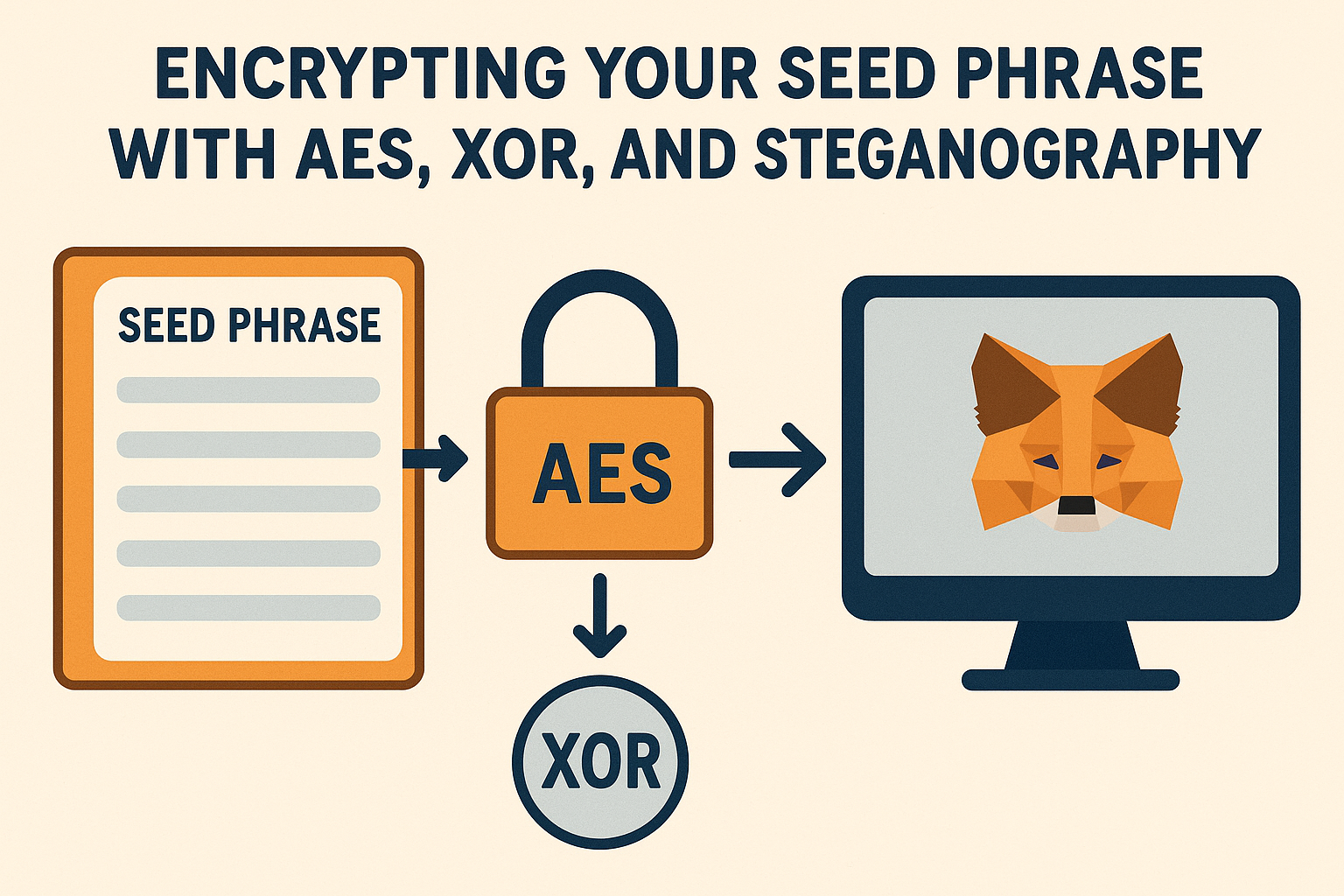In the realm of cryptocurrency and blockchain technology, your seed phrase represents the master key to your digital assets. Typically consisting of 12, 18, or 24 words derived from the BIP39 standard, this mnemonic phrase enables recovery of your private keys and, consequently, access to your funds. While many users understand the importance of securing their seed phrase, relatively few implement additional layers of protection beyond physical storage.
This comprehensive guide explores advanced methods for encrypting and protecting your seed phrase, moving beyond basic security practices to establish robust, multi-layered protection schemes that significantly enhance the security posture of your cryptocurrency holdings.
This article focuses on supplementary protection for your seed phrase. Remember that these techniques should complement—not replace—secure physical storage practices such as metal backups and proper geographic distribution of recovery information.
The Critical Importance of Seed Phrase Security
Before diving into encryption techniques, it's vital to understand what's at stake. Your seed phrase is effectively a human-readable representation of the master private key that controls your cryptocurrency assets. Unlike traditional banking systems that offer account recovery options and fraud protection, blockchain technologies provide immutable, irreversible transactions where ownership is determined solely by private key control.
According to research from Chainalysis, over $3.8 billion in cryptocurrency was stolen in 2022, with a significant portion of these losses stemming from compromised seed phrases and private keys. The immutable nature of blockchain means that once assets are transferred, they cannot be reclaimed without the new owner's consent.
A compromised seed phrase typically leads to immediate and complete loss of all associated digital assets. Unlike password breaches in traditional systems, there are no second chances or recovery mechanisms built into most blockchain protocols.
Understanding Encryption Basics
Encryption transforms readable data (plaintext) into an encoded format (ciphertext) that can only be viewed or processed after decryption with the appropriate key. When applied to seed phrases, encryption adds a critical layer of security that protects against unauthorized access even if the physical storage medium is compromised.
The fundamental encryption methods we'll explore include:
- AES (Advanced Encryption Standard) — A symmetric encryption algorithm widely recognized for its security and efficiency
- XOR Operations — A simple yet effective bitwise operation that can be used for basic encryption
- Steganography — The practice of concealing information within ordinary, non-secret data or files
Each method offers distinct security properties and practical considerations that make them suitable for different security scenarios and user requirements.
The ideal encryption approach often combines multiple methods, creating security through defense in depth rather than relying on a single protection mechanism.
AES Encryption for Seed Phrases
AES (Advanced Encryption Standard) has become the gold standard in symmetric encryption, adopted by governments and security professionals worldwide. For seed phrase protection, AES provides mathematical assurance against brute force attacks when implemented correctly.
The core strength of AES lies in its key length options (128, 192, or 256 bits) and its demonstrated resistance to cryptanalysis. The National Institute of Standards and Technology (NIST) selected AES through a rigorous evaluation process, and it continues to withstand scrutiny from the cryptographic community.
Implementation Guide
To encrypt your seed phrase using AES:
- Choose a strong passphrase — This should be lengthy, complex, and memorable only to you
- Select an appropriate AES mode — GCM (Galois/Counter Mode) is recommended as it provides both confidentiality and data integrity
- Generate a random salt — This prevents identical passphrases from producing identical encryption results
- Derive an encryption key — Use a key derivation function like PBKDF2 with sufficient iterations
- Encrypt the seed phrase — Apply the AES algorithm with your derived key
- Store the ciphertext, salt, and parameters — Keep these together as you'll need them for decryption
Tools and Applications
Several well-vetted tools can help implement AES encryption for your seed phrase:
| Tool | Platform | Key Features | Security Considerations |
|---|---|---|---|
| OpenSSL | Cross-platform (CLI) | Industry standard, highly configurable | Command line complexity, requires technical knowledge |
| VeraCrypt | Windows, macOS, Linux | Creates encrypted containers, plausible deniability | Ensure clean shutdown to prevent memory attacks |
| KeePassXC | Cross-platform | Password manager with secure notes | Master password becomes a single point of failure |
| GnuPG | Cross-platform | Industry standard for file encryption | Key management complexity |
When using AES, the security of your encrypted seed phrase is only as strong as your encryption password. A 256-bit AES encryption with a weak password might be easier to break than a 128-bit encryption with a strong passphrase.
The XOR Method: Simple Yet Effective
The XOR (exclusive OR) operation provides a straightforward but mathematically sound approach to encrypting your seed phrase. While less sophisticated than AES, XOR encryption offers unique advantages, particularly when implemented as part of a layered security strategy.
XOR works by combining each bit of your seed phrase with a corresponding bit from your key using the XOR logic gate. The resulting ciphertext can only be decrypted by applying the same key with another XOR operation—a property known as involution.
The XOR operation's mathematical property can be expressed as: (A ⊕ B) ⊕ B = A, meaning that applying the same key twice reverts to the original value.
Practical Implementation
To implement XOR encryption for your seed phrase:
- Convert your seed phrase to binary — Typically done by converting to ASCII/UTF-8 and then to binary
- Generate or choose a key — This should be at least as long as your seed phrase
- Perform the XOR operation — Combine each bit of your seed phrase with the corresponding bit of your key
- Store the resulting ciphertext — Along with a secure way to remember or recover your key
Advantages and Limitations
XOR encryption offers several benefits:
- Simplicity — Easy to implement, understand, and perform mentally or with minimal tools
- Perfect secrecy — When used with a truly random, one-time key of equal length
- Speed — Extremely fast compared to more complex algorithms
- No dependencies — Can be implemented without specialized cryptographic libraries
However, it also has important limitations:
- Key management — Requires secure generation and storage of keys
- No integrity checking — Cannot detect if ciphertext has been tampered with
- Pattern vulnerability — When keys are reused or predictable
XOR encryption works particularly well as part of a multi-layered approach, where the simplicity of XOR complements the strength of more complex algorithms like AES.
Steganographic Techniques
While encryption transforms your seed phrase into unreadable ciphertext, steganography takes a different approach by hiding the very existence of the secret data. This technique conceals your seed phrase within ordinary-looking carriers such as text, images, audio, or video files.
The primary advantage of steganography is its ability to avoid attracting attention to the protected data. Even the most secure encryption can be targeted if an adversary knows that encrypted data exists, but steganographic methods help bypass this by hiding the presence of sensitive information.
Text-Based Steganography
Text-based steganography methods are particularly relevant for seed phrases, as they allow you to hide your mnemonic within seemingly innocent text content. These techniques include:
- Linguistic steganography — Encoding information within the structure of natural language
- Format-based methods — Using spacing, formatting, or invisible characters
- Acrostic techniques — Where the first letters of words or lines spell out the hidden message
- Semantic methods — Embedding information within the meaning of text
A practical approach for seed phrase protection is to create a meaningful text where specific words or patterns encode your seed phrase words. This could be a story, poem, or recipe where predetermined positions contain the actual seed words or clues to them.
Image-Based Steganography
Images provide excellent carriers for steganographic content due to their large data capacity and the human eye's limited ability to detect subtle changes in visual information. For seed phrase protection, consider:
- LSB (Least Significant Bit) insertion — Modifying the least significant bits of pixel values
- DCT domain methods — Embedding data in the frequency domain (common in JPEG images)
- Spatial domain techniques — Changing pixel values directly
- Visual cryptography — Splitting an image into shares that reveal information only when combined
When using image steganography, consider working with lossless formats like PNG rather than lossy formats like JPEG, as compression can destroy subtle steganographic data.
Recommended Tools
Several well-regarded tools can help implement steganographic protection:
| Tool | Type | Features | Best For |
|---|---|---|---|
| Outguess | Image steganography | Advanced statistical techniques to avoid detection | High-security requirements |
| Steghide | Image/audio steganography | Encryption of embedded data, graph-theoretic approach | Multiple file format support |
| Snow | Text steganography | Uses whitespace encoding | Simple text document hiding |
| OpenStego | Image steganography | User-friendly interface, open source | Beginners seeking ease of use |
While steganography can hide the existence of protected data, it typically offers weaker cryptographic security than dedicated encryption algorithms. For maximum protection, encrypt your seed phrase before applying steganographic techniques.
A Combined Approach: Multilayered Security
The most robust protection for your seed phrase comes from combining multiple methods, creating defense in depth that requires an attacker to bypass several independent security measures. A layered approach might look like:
- First layer: AES encryption — Encrypt your seed phrase using AES-256 with a strong passphrase
- Second layer: XOR transformation — Apply an XOR operation with a separate key to the encrypted data
- Third layer: Steganography — Hide the twice-protected data within an ordinary file
- Fourth layer: Physical security — Store the carrier file securely, potentially across multiple locations
This approach creates multiple distinct security barriers, each requiring different attack vectors to overcome. Even if one layer is compromised, the remaining protections continue to safeguard your seed phrase.
According to a 2020 research paper on multilayer security, combining encryption with steganography can provide exponentially greater protection than either method alone.
A practical implementation might involve:
When implementing multilayered security, ensure that you maintain recovery paths for each layer. Document your method securely, as the complexity increases the risk of accidentally locking yourself out of your own assets.
Understanding the Risks and Trade-offs
While encryption adds valuable protection to your seed phrase, it also introduces new risks that must be carefully managed:
Security vs. Recoverability Trade-off
Every layer of protection adds complexity to the recovery process. This fundamental trade-off means that as security increases, the risk of permanently losing access due to forgotten passwords, lost keys, or procedural errors also increases.
Research by Chainalysis suggests that 10-20% of all Bitcoin is likely lost forever due to lost private keys and seed phrases, representing billions in inaccessible assets.
Key Considerations
- Inheritance planning — Consider how authorized parties could access your assets in case of emergency or death
- Memory dependency — Avoid systems that rely solely on memorized information
- Technological obsolescence — Ensure your encryption methods and tools will remain accessible in the future
- Testability — Regularly verify that your recovery process works as expected
| Risk Factor | Description | Mitigation Strategy |
|---|---|---|
| Password loss | Forgetting encryption passwords or keys | Create secure password hints, consider secure sharing mechanisms |
| Process complexity | Too many steps leading to procedural errors | Document processes clearly, test recovery periodically |
| Single points of failure | Critical components with no redundancy | Create backup systems and redundant storage |
| Software dependency | Reliance on specific software that may become unavailable | Prefer open standards and widely adopted tools |
Best Practices and Recommendations
Based on industry best practices and security research, here are recommendations for implementing encrypted seed phrase protection:
For Beginners
- Start simple — Use a single strong encryption method like AES with a password manager
- Test thoroughly — Practice the entire encryption and decryption process with small amounts
- Document clearly — Create simple, clear recovery instructions and store them securely
- Use established tools — Avoid creating custom systems until you're experienced
For Advanced Users
- Implement defense in depth — Combine multiple protection methods
- Create geographic redundancy — Store encrypted backups in multiple physical locations
- Consider key sharding — Split encryption keys using Shamir's Secret Sharing
- Establish inheritance protocols — Create secure mechanisms for authorized access in emergencies
Many cryptocurrency security experts recommend the 3-2-1 rule: maintain at least three copies, on two different media types, with one copy stored off-site. This principle applies equally well to encrypted seed phrases.
Universal Recommendations
- Never store unencrypted seed phrases digitally — Not even temporarily
- Use air-gapped devices — Perform encryption on devices without network connectivity
- Test recovery periodically — Verify that your process works at least annually
- Keep physical security — Encryption doesn't eliminate the need for physical protection
- Balance security and usability — The most secure system is worthless if too complex to use
Remember that encryption is most effective as part of a comprehensive security approach, not as a standalone solution.
Conclusion
Encrypting your seed phrase provides a powerful additional layer of security for your cryptocurrency assets, significantly reducing the risk of loss due to theft or unauthorized access. By implementing AES encryption, XOR operations, steganographic techniques, or—ideally—a combination of these methods, you establish a robust defense system that complements traditional physical security measures.
The ideal approach balances security with recoverability, acknowledging that protection mechanisms must not only deter attackers but also remain accessible to you when needed. This balance requires thoughtful planning, regular testing, and clear documentation.
As blockchain technology continues to evolve and cryptocurrency adoption grows, implementing these advanced protection techniques puts you at the forefront of personal digital asset security, ensuring that your investments remain safe even as threat landscapes change.
Remember that security is a journey, not a destination. Regularly review and update your protection strategies as new technologies and threats emerge.



